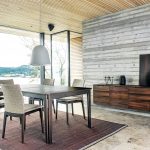Furniture should be cosy. It should be stylish. It should be enduring.
Above all else, furniture should be something that you love. Choosing the right furniture that feels like you is important. It defines the look and feel you want to create in your home.
Biophilic design
Connecting with nature is good for the soul. Research shows that this instils a sense of calm and lowers blood pressure. It also boosts creativity and happiness. At its heart, biophilic design is all about connecting humans and the natural world. By bringing the outdoors in through the use of natural materials in furniture, you can create beautiful inspired spaces. Wool, ceramics, stone, timber, jute and silk are all examples of natural materials. By using these in furniture, you are connecting to nature in a very authentic way. Sarah Yarrow, from Sarah Yarrow Interiors, says that post pandemic, we have even more desire to bring the outdoors into our homes. “We do this by bringing in plants and incorporating botanical fabrics. This extends through to designing architectural homes with a complete focus on wellbeing,” she notes.
Looking at furniture shapes, Sarah says there has been more emphasis on natural forms. “There is definitely that real nod to nature,” she says. “When you look at nature, things aren’t designed at perfect right angles; there are also a lot more curves.” Circular or oval coffee and side tables, and mirrors in curved formats are one example of this trend. Ottomans in organic shapes are another example. While many are eager to embrace the concept of biophilic design, Sarah says it isn’t something new. But Sarah also says it is becoming more widespread as we seek ways to live healthier lives. “It’s about taking cues from previous generations and going back to when life was simpler. Design styles of that time often used hardwood timbers, linens, cottons and stone.”
The furniture you choose should feel good and it should offer you comfort. As Sarah explains, biophilic is a very holistic approach to wellness. “If you have a beautiful chair you love to sit in at the end of the day that helps you relax and unwind, your furniture is giving you a big hug,” she shares.

Designed and built to last
What does quality furniture mean to you? An heirloom piece you can hand down through the generations? Something crafted from timber? A bespoke piece of furniture that is a one-of-a-kind? It turns out it’s actually something you can’t see. Covesmore Solutions CEO, Dan Hurditch, says quality furniture lies beneath the surface. “The joints of a chair, type of glue used, and the springing system used in a lounge” are some of the many example he says. “In today’s throw-away society, this is not fully understood by most customers as these qualities are not present in the average home. This is not an issue of the customer’s choice, but an issue of the manufacturer who is happy to release mediocre furniture into our society and mislead their customers for financial gain.
Of course, we need these mediocre furniture pieces to make sure furniture is accessible to everyone. “When it comes to choosing any furniture pieces for my home, they need to adhere to the above qualities and also boast of a simple yet functional design. A hero piece will not only obey my rules of quality and comfort, but also serve as a spectacle and centrepiece of the room. This piece will draw people’s attention and demand remarks from visitors,” says Dan.

The rise of retro
Whether it’s the nostalgic ’50s with clinched waists, or platforms of the ’70s, retro clothing is very cool. Love a retro look? why not incorporate that into your interiors with vintage furniture and design?
Many people love the charm of a bygone era. Going retro is a way to revisit the past and put your own spin on classic furniture pieces. If you source a retro piece of furniture, make sure it works well with your home interior. Going retro doesn’t mean replicating an interior space so it looks like something out of the 1960s. Sometimes it’s the subtle touches from select pieces of furniture that resonate with you. It’s possible to mix retro with modern, too. Older pieces of furniture do have more volume and take up more space than modern slimline pieces. Make sure your vintage furniture doesn’t overwhelm the space. Work the new retro pieces in with your existing colour scheme so it doesn’t clash. Finally, select a hero piece, something you love, and let it shine in a prominent place in the room.

Kids’ zones
When designing a bedroom, playroom or teen retreat, it can be a challenge. The room will need to grow with the child, there should a balance of space for storage, sleeping and play. Kids will also want to have their say, which may not jibe with what you had in mind.
Kids can outgrow furniture in a short time, so choices should be wise. Choosing pieces that have design flexibility or various applications is a good idea. For example, sofa beds are great for seating and optimizing extra space.
Furniture can, of course, also include built-in joinery. Nicole Rosenberg says, to always think about the piece’s longevity. “A built-in change table will only last two years. Instead, incorporate built-in cupboards either side of a table that can serve as a change table then an activity table, then a desk,” she says.

When purchasing a bed for your child, Nicole says it can pay to upsize and skip the in between. “People are hesitant to jump from a cot to a king single or even a double, but if you have room, I always recommend it,” she notes. “Kids will love it when they have sleepovers, or you’ve a larger bed for adult guests.”
If storage is in short supply, a bigger gas-lift bed can also offer space. “They’re so clever and easy for even a child to lift,” she says. Kids’ bedside tables are also a great idea so they have room to store their treasures and trinkets.
In living zones, kids need space to store their toys and games. Built-in joinery cupboards will work when they’re small, says Nicole, but factor in design flexibility for when they outgrow their toys. “For example, a built-in toy cupboard in a living room with brass handles, can be converted to a built-in bar later by adding some stone,” explains Nicole.
When decorating your child’s bedroom, again flexibility is key. The pretty pink paint they adored as a five-year-old won’t cut it anymore as a pre-teen. Nicole suggests, Removable wallpaper as an option to work your child’s change in taste.
The importance of choosing furniture for outdoor spaces
In contemporary homes, living spaces continue to spill outdoors. Outside furniture is evolving in response to growing demand for products that will go the distance outdoors.
In the past decade, fabrics and materials incorporated in outdoor furniture have changed. Eloise Sim from Cosh Living says, outdoor spaces are no longer an afterthought. “With the introduction of innovative all-weather materials and fabrics that mimic the look and feel of indoor furniture, this perception has changed,” Eloise notes. But that’s only part of the story.
With more and more of us embracing outdoor living, designers have risen to the challenge of crafting furniture that is robust and sustainable.

Choosing the right furniture that feels like you: Material matters
Eloise says there has also been a focus on producing versatile and comfortable outdoor furniture. Embracing modern design trends and technology to enhance outdoor living spaces. “These changes have allowed people to make the most of their outdoor areas not only in functionality, but also through creativity of choosing materials and layout.” Eloise points out.
She adds there are plenty of sizzling new looks in outdoor furniture that are easy on the eye and long-lasting. “Modern and minimalist designs with clean lines are popular in Australian homes, along with subtle natural tones and textures in organic shapes. Versatile modular designs are also gaining traction.”

Choosing the right furniture and fabrics sets the scene for comfort and liveability. Accessorising your outdoor furniture is what takes it to the next level of style. Eloise recommends adding layers of textured fabrics to elevate your outdoor furniture. “Soft-to-touch materials such as bouclé on cushions, or a woven patterned fabric on throws are among our top choices,” she reveals.

























